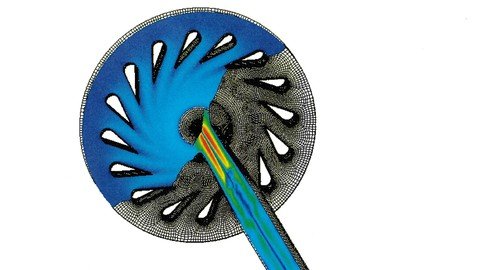
MP4 | Video: h264, 1280×720 | Audio: AAC, 44.1 KHz
Language: English | Size: 3.09 GB | Duration: 2h 34m
Learn to Write Your Own Codes Using the Finite Volume Method
What you’ll learn
The basics of computational fluid dynamics using the finite volume method.
Requirements
Basic programming skills in a language such as C, Fortran, Python, etc. Knowledge of basic calculus, differential equations, numerical methods, and fluid mechanics is suggested..
Description
This course will cover the basics of the finite volume method for incompressible flows on two-dimensional Cartesian grids. Topics include the discretization procedure, interpolation techniques, boundary conditions, flow visualization using ParaView, and CFD errors and uncertainty. Students will write three codes; the first code solves a pure diffusion problem, the second solves a pure convection problem, and the third solves the Navier-Stokes equations using the SIMPLE pressure-velocity coupling procedure. The Navier-Stokes solver will be used to solve the “driven cavity” problem, and a problem involving the developing flow in a channel. These three codes are also available for download to, for instance, study the solution procedure, or help in debugging a student written code. Upon completion of the course students will be familiar with the basics of the finite volume method, enabling a more effective use of a commercial CFD solver, and possess the background necessary to study more advanced CFD techniques.
Overview
Section 1: Introduction
Lecture 1 A Brief Introduction to CFD and what we will cover in this course.
Lecture 2 Some representative, low-cost CFD results.
Section 2: A review of Finite Difference Approximations and Iterative Methods.
Lecture 3 Derivation of FInite Difference Approximations
Lecture 4 Basic Iterative Solvers
Section 3: Finite Volume Method for Diffusion Problems
Lecture 5 Discretization of Diffusion Terms: Part 1
Lecture 6 Discretization of Diffusion Terms: Part 2
Lecture 7 Discretization of Diffusion Terms: Boundary Conditions
Lecture 8 An Example Problem
Lecture 9 Fortran Code for Example Diffusion Problem
Lecture 10 Section of Fortran Code to Write .csv FIle for ParaView
Lecture 11 Visualization Using ParaView
Section 4: Finite Volume Method for Convection Problems
Lecture 12 Discretization of Convection Terms
Lecture 13 Interpolation Methods: Central “Differencing”
Lecture 14 Interpolation Methods: 1st Order Upwinding
Lecture 15 Deferred Correction to “Blend” Interpolation Schemes
Lecture 16 An Example Problem: Description
Lecture 17 Upwinding Component Boundary Conditions for Example Problem
Lecture 18 Central Differencing Component Boundary Conditions for Example Problem
Lecture 19 Corner Cell Coefficients
Lecture 20 Fortran Code for Example Convection Problem
Lecture 21 Results
Lecture 22 Other Interpolation Schemes
Lecture 23 Interpolation Scheme Truncation Errors
Lecture 24 Generalization of Interpolation Schemes
Lecture 25 Desirable Properties of Discretization Schemes
Lecture 26 Stability of Combined Convection/Diffusion Problems
Section 5: Finite Volume Method for the Navier-Stokes Equations
Lecture 27 The Navier-Stokes Equations
Lecture 28 Staggered Grid Arrangement of Variables
Lecture 29 The SIMPLE Procedure for Pressure-Velocity Coupling
Lecture 30 Discretization of the X-Momentum Equation: Part 1
Lecture 31 Underrelaxation of the Momentum Equations
Lecture 32 The Velocity Correction Equations
Lecture 33 The Discretized Continuity Equation
Lecture 34 Index Notation for Navier-Stokes Solver (Code) on Staggered Grid
Lecture 35 Fortran Code for Navier-Stokes Solver
Lecture 36 Description of Driven Cavity and Developing Flow in a Channel Problems
Lecture 37 Driven Cavity Results Using ParaView
Lecture 38 Channel Flow Results Using ParaView
Lecture 39 Other Boundary Conditions
Section 6: Errors and Uncertainy in CFD
Lecture 40 CFD Errors and Uncertainty
Upper division undergraduate and beginning graduate level engineering, mathematics, and science students. Engineers and scientists working in industry who would like an introduction to CFD.
Password/解压密码www.tbtos.com
转载请注明:0daytown » An Introduction To Computational Fluid Dynamics (Cfd)